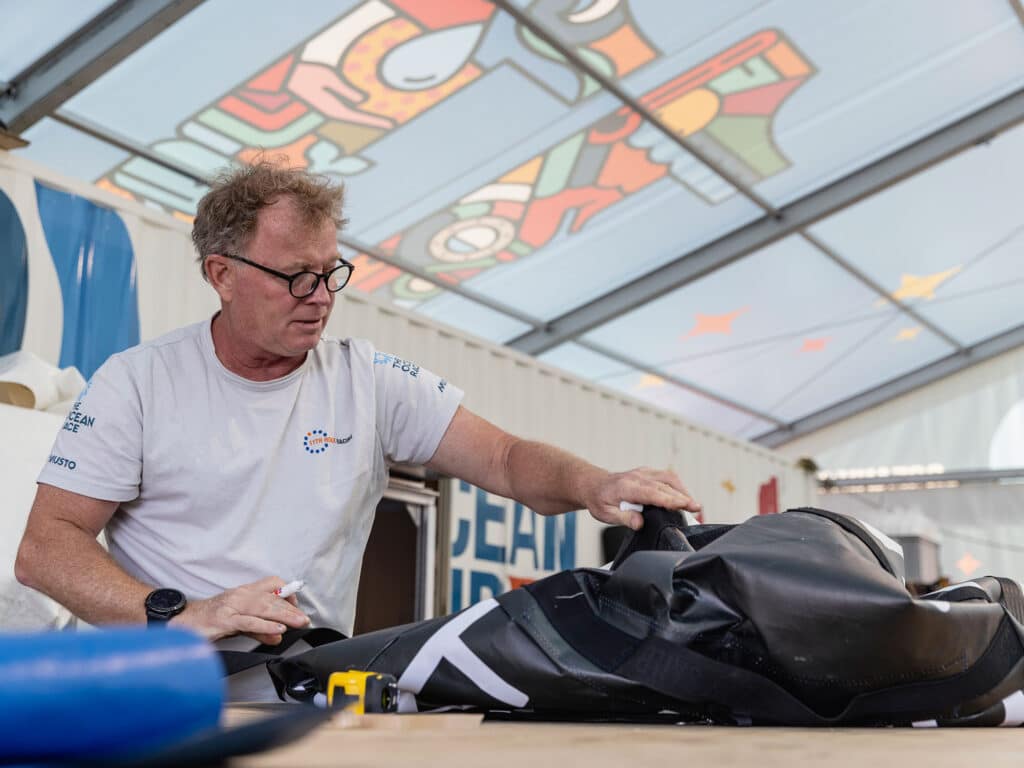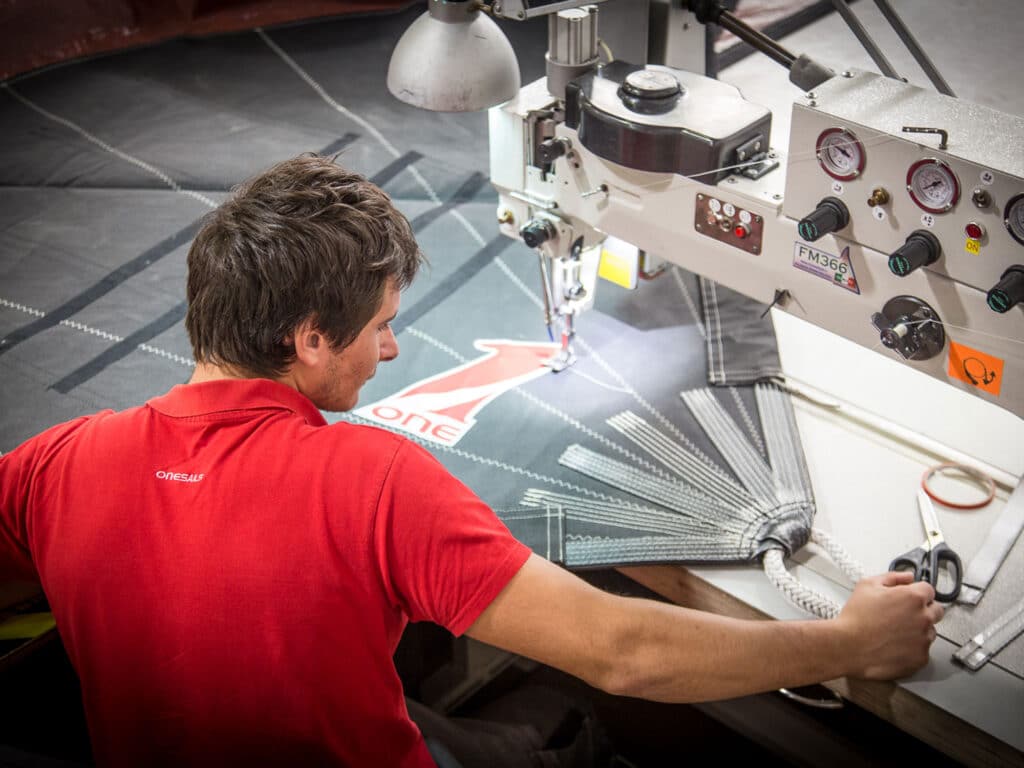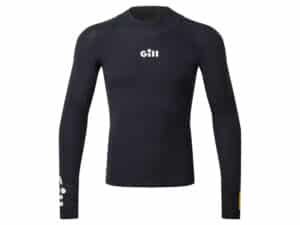
Sailboat racing, and the sailing industry at large, is anything but green despite being a sport powered by wind. Hulls, sails, cordage and most components are largely derived from fossil fuels, and sailors, as end users, ultimately consume a lot of petroleum. Industry resources, however, are now being devoted to reducing the sport’s footprint. One area that is seeing a shift toward sustainability is sail manufacturing. Typically built from petroleum-based fibers and film, these consumable items are an obvious place to start pushing for innovation.
As the world’s premier offshore racing environment, the IMOCA 60 Class, which is used in both the Vendée Globe and The Ocean Race—has taken charge by mandating sustainability into the sail inventories of these well-funded teams. Beginning in 2023 and 2024, each IMOCA team will be required by class rules to carry at least one “green sail.” With these 60-foot ocean foilers limited to carrying eight sails in a race, the new green sail rule is seen as a small but necessary step in the right direction. To qualify as a green sail, sailmakers must prove a reduction in waste consumed as well as deriving at least 25 percent of energy used in sail production from renewable sources and avoiding aviation travel in the sail’s production and implementation.
“The green sail rule came about because it was an ambition from the class members to start to reduce the impact of the sails for the IMOCA boats,” says Imogen Dunham-Price, Sustainability Manager for the class. “We didn’t know how to define a green sail, so we contacted the sailmakers and then followed with a life-cycle assessment of an IMOCA sail. The key areas we identified were waste, energy and transport in the sail manufacturing process. So, we said let’s go and tackle improvements in those areas first.”
11th Hour Racing’s IMOCA design and build report from 2021 revealed a staggering figure that underscores just how wasteful and dirty sail making and boatbuilding really is: for every kilogram of sail produced, there are at least 6 kilograms of raw and secondary materials consumed. Between fibers and resins used in creating a sail and consumable materials such as gloves, tape, paper, etc., there is significant waste that results from the manufacture of each new racing sail. Extrapolating these figures out for an entire sail inventory, with sails weighing somewhere around 1,100 to 1,300 pounds, there is approximately two to three tons of waste—in sails alone—for each and every boat in the IMOCA fleet. While this figure is a considerable amount of waste and byproduct, it also represents an opportunity to achieve a meaningful reduction in waste.
“As the awareness has grown around sustainability, we were five years ago talking about compromise and additional cost, but more and more the solutions out there provide not just better business practice but financial and operational gains as well,” says Damian Foxall, 11th Hour Racing’s Sustainability Manager. “Things begin to snowball and accelerate in the right direction. We’ve had some fun wins in regards to sustainability, some small, some big. We did an audit on everything and just one small way we improved was by stockpiling and sending cardboard and other supplies back to suppliers. Not only was there financial gain for both parties but there was a huge reduction in waste. When you get sustainability and finance doing the same thing, it’s a win-win.”
Another way is to get used carbon fiber out to recyclers, Foxall says. “In some ways, carbon is becoming harder and harder to get, so we need to get that carbon out to the right recyclers and for them to feed that carbon back to us in the right form.”
Transforming one product to another product, however, demands additional raw energy, Foxall says. “In our study, which was backed up to a previous life-cycle assessment, the first question to ask suppliers is where does your energy come from? It’s maybe not something you immediately think about for a green sail, but energy is the first thing you should be looking at. There are big gains to be had, and it’s oftentimes a cheaper and/or similar cost. One of the sail lofts which is doing quite good work and being leaders on alternative materials is OneSails. They have a nominally circular material process which is theoretically recyclable. Kudos to them. It’s important for the IMOCA class to get to a circular space in terms of materials. The complication when you go too quickly down that route, however, is you end up with issues of durability. So, what the green sail rule is…on one hand it’s intended to be pragmatic but also to incentivize teams to improve.”

Top-level racing yachts can go through sails very quickly, so anything that can significantly increase durability is a victory in terms of sustainability. If a mainsail that used to get replaced every two years or perhaps every four-year Vendée Globe cycle manages to go twice as long as before, then that is a measurable reduction in waste and energy consumed. With that in mind, 11th Hour Racing and other racing programs swear by the longevity of North Sails 3Di.
“The most sustainable sail is 3Di,” Foxall says. “They don’t change shape and they last forever, so we’re trying to beat something that is pretty good in terms of durability. The next step is to clean up the construction process.”
Part of the green sail rule is to incentivize teams to create a life-cycle assessment for each new sail, with the goal being sails that stay on the racetrack longer. Striking a balance between real sustainability gains and the unimpeded pursuit of performance at all costs is no trivial challenge. Alternative materials now exist to make a real and tangible impact in terms of sustainability, and they’re evolving rapidly. In the most recent Vendée Globe, Pip Hare and Ari Huusela each raced around the world with working sails that were ISO 14040 certified to be fully recyclable. With both sailors using sails built using OneSails’ “4T Forte” technology, they have proven that a recyclable, more sustainable sail can be built, one that offers good performance and enough reliability to make it around the world.
“We began using thermoplastic as a bonding agent rather than adhesives,” says Mark Washeim of OneSails. “There were a lot of advantages to this; the main one being that the bond was molecular rather than chemical. The sails weren’t glued together, they were unified. The thermoplastic would encapsulate the fibers, and the bundle of fibers would remain soft. It’s kind of like an extension cord where you have metal cables encapsulated in plastic, so that the bundles would not fracture. This allowed the use of lightweight, low-stretch membranes. An additional advantage of this method of sail construction was that the sail could be made to be recyclable.”
Another sustainability gain, Washeim says, is a reduction in carbon dioxide emissions of other systems, including Dacron. “It does it without the use of pollutants such as glues, resins and solvents. It’s very clean and has all kinds of certifications and documentation for being green. And it is. Our technology was the first racing sail to be certified as being fully recyclable, but it’s not like you can take a sail and throw it into a recycling bin and turn it into another lower-grade plastic. The membrane has to be stripped of its additional components like Dacron edge tapes, batten pocket components, luff slides, corner rings, etc.”
While OneSails may be the first company to build a recyclable racing sail to go around the world in the Vendée Globe, their core goal of more sustainable sail production is shared by many industry leaders and is already trickling down. Challenge Sailcloth has recently introduced their “Palma” line of sailcloth which uses their new UPE material that is made entirely from recycled polyester fiber and films. UPE is Challenge’s acronym for their recycled variant of ultra-high molecular weight polyethylene (UHMWPE), which is the same material as Spectra or Dyneema. From a sail-making perspective, it’s darn good stuff. It’s relatively light weight, super strong and resists chafe, tearing and stretching. In other words, it’s nearly bullet proof and holds its shape well. By making a UHMWPE cloth from recycled materials and then gluing it together with a proprietary adhesive that includes no volatile organic compounds (VOCs) nor harmful solvents, Challenge has innovated a new means of building sails that uses 100-percent recycled materials, reduces greenhouse gas emissions during construction and can be recycled. By supplying this cloth to a lot of the industry, consumers can now purchase sails built from sustainable cloth from sailmakers such as Quantum, OneSails, Elvstrøm and others.
The net gains of the IMOCA class’ new ‘Green Sail’ rule remains to be seen. But with IMOCA teams now forced to consider the carbon footprint, usable life cycle and waste generated from what will likely be the next sail purchased in their inventory, it is a start, and it does move the needle and the conversation in the right direction. With new materials and construction processes constantly being innovated and tested on what is the most demanding race track on earth, these sustainable practices should do more than just clean up IMOCA class’ sail programs. They stand to push an industry-wide shift that will spread to other racing classes and club racers.









